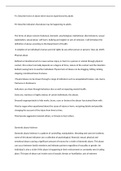P1: Describe forms of abuse which may be experienced by adults
P2: Describe indicators that abuse may be happening to adults
The forms of abuse consist of physical, domestic, psychological, institutional, discriminatory, sexual
exploitation, sexual abuse self harm, bullying and neglect or acts of omission. I will introduce the
definition of abuse according to the Department of Health:
‘A violation of an individual’s human and civil rights by any other person or persons’ (Gov.uk, 2019).
Physical abuse
Defined as intentional acts to cause serious injury or harm to a person or animal through physical
contact, this contact normally depends on a degree of force, nature of the contact and the intention
behind causing harm to another individual. Physical acts of abuse can be dragging, hitting, kicking,
slapping, intentional bone fractures.
Physical abuse can be shown through a range of indicators such as unexplained bruises, cuts, burns,
fractures or disclosures.
Indicators can show through behaviour also as well as impacting mental health.
Some are; wariness or highly anxious of certain individuals; the abuser.
Dressed inappropriately to hide marks, burns, scars or bruisers the abuser has stained them with.
May be vague when questioned about the cause of injury or harm, not giving details and possibly
changing the account of the injury from time to time.
May become aggressive towards others, or threats to hurt others.
Domestic abuse/violence
Domestic abuse/violence is a pattern of controlling, manipulative, threating and coercive incidents,
some of this abuse indicators are a collection of psychological, financial, sexual, physical and
emotional abuse causing a significant amount of trauma for a victim of domestic abuse. This abuse
can occur between family members and intimate partners regardless of sexuality or gender. An
individual is also a victim if this abuse is happening in their environment or constantly sees it taking
place. This type of abuse can involve acts of assault, threats or humiliation, acts of extreme
, punishment, isolation of the victim from friends and family, exploitation of finances, preventing the
victim escaping from abuse.
- Some indicators include; Isolation e.g. from family and friends, overt use of verbal abuse and
humiliation, lack of access to finances, physical evidence of acts of physical violence, low self esteem,
fearfulness and self doubt that the abuse is their fault.
Psychological abuse
Psychological abuse is when a abuser constantly brings another individual down through the use of
verbal abuse, bullying, intimidation, isolating the victim away from family and friends in order to
have full mental control over them and make them feel undervalued and unequal or unworthy.
Indicators of this abuse include; withdrawal from society and others, silence around a certain person
(the abuser), low self-esteem, dramatic weight loss/gain from change of appetite, distress,
tearfulness, anger and insomnia.
Institutional abuse
Institutional abuse is mistreatment of individuals as a result of poor standards of the institution.
Commonly comes about as a result of neglected wishes and needs of individuals for smooth running
of the institution, service or group. For example in a care setting this be shown by not meeting care
of conducts within the setting and looking only at the money profit of the institution, making that a
main priority over the health of service users.
Indicators;
Poor standards of care, poor record and document keeping, loss of documents, loss of care plans,
public discussion of personal matters, lack of appropriate and adequate polices and procedures, lack
of management and support as a whole, people being hydrated or hungry.
Discriminatory abuse




